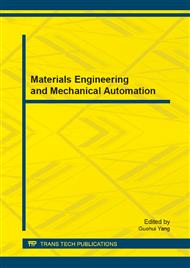[1]
K.W. Ogden: The distribution of truck trips and commodity flow in urban areas: A gravity model analysis. Transportation Research, 12(2), (1978).
DOI: 10.1016/0041-1647(78)90052-7
Google Scholar
[2]
K.W. Ogden: Urban Goods Movement: a Guide to Policy and Planning. Ashgate Publishing Limited Aldershot UK, (1992).
Google Scholar
[3]
A.C. Regan, R.A. Garrido: Modeling Freight Demand and Shipper Behaviour: State of the Art, Future Directions. Proceedings of 9th International Association for Travel Behaviour Research Conference, Gold Coast, Queensland, Australia, (2000).
DOI: 10.1016/b978-008043924-2/50006-7
Google Scholar
[4]
E. Taniguchi, R.G. Thompson: City Logistics. Institute of Systems Science Research, Japan, (1999).
Google Scholar
[5]
Taniguchi E., Van Der Euden. An evaluation methodology for city logistics. Transport Reviews, 20 (1), (2000).
Google Scholar
[6]
F. Russo, A. Comi: Urban freight movements: quantity attraction and distribution models. Sustainable Planning & Development, eds E. Beriatos, C. A. Brebbia, H. Coccossis and A. Kungolos, WIT Press. Skiathos Island, 1 -3 October 2003, (2003).
Google Scholar
[7]
F. Russo, A. Comi: A modelling system to simulate goods movements at an urban scale. Transportation, 37(6), (2010), pp.987-1009.
DOI: 10.1007/s11116-010-9276-y
Google Scholar
[8]
F. Russo, A.G. Cartisano and A. Comi: Modelli per l'analisi degli anelli finali della distribuzione delle merci. Modelli e metodi dell'Ingegneria del traffico, G. E. Cantarella e F. Russo, Franco Angeli, (2002).
Google Scholar
[9]
A. Nuzzolo, U. Crisalli, and A. Comi: A modelling system for urban goods movements. In Sustainable transportation, Proceedings of the 11th international conference of Hong Kong Society for transportation studies. December 9-11, 2006, edited by S. C. Wong et al., Hong Kong Society for transportation studies, (2006).
Google Scholar
[10]
A. Nuzzolo, U. Cristalli, A. Comi and F. Sciangula: Distribuzione urbana delle merci tramite ferrovia regionale: un'applicazione test nella penisola Sorrentina. Milano, Franco Angeli, (2007).
Google Scholar
[11]
C. Ambrosini, J. Routhier: Objectives, methods and results of surveys carried out in the field of urban freight transport: an international comparison. Proceedings of 9th World Conference on Transport Research, Seoul, (2001).
DOI: 10.1080/0144164032000122343
Google Scholar
[12]
F. Filippi, A. Nuzzolo, A. Comi and P. Delle Site: Ex-ante assessment of urban freight transport policies. Paper presented at the Procedia - Social and Behavioral Sciences, 2(3), (2010), pp.6332-6342.
DOI: 10.1016/j.sbspro.2010.04.042
Google Scholar
[13]
F. Crocco, S. De Marco, P. Iaquinta, and D. Mongelli: RP surveys on socio-economic, demographic characteristics and consumer behaviour in a middle-sized city. an integrated system of models to forecast freight demand and passengers demand for purchase trips. The International Conference on Urban Planning and Transportation - Proceedings, (2010).
Google Scholar
[14]
F. Crocco, S. De Marco, P. Iaquinta, and D. Mongelli: Freight transport in urban areas: An integrated system of models to simulate freight demand and passengers demand for purchase trips. International Journal of Mathematical Models and Methods in Applied Sciences, 4(4), (2010).
DOI: 10.4028/www.scientific.net/amm.442.634
Google Scholar
[15]
B.G. Hutchinson: Principles of urban transportation systems planning. McGraw-Hill Book Company, Washington, D.C., (1974).
Google Scholar
[16]
G.F. List and M.A. Turnquist: Estimating truck travel patterns in urban areas. Transportation Research Record, 1430, (1994).
Google Scholar
[17]
S.Y. Taylor: A Basis for Understanding Urban Freight and Commercial Vehicle Travel. ARRB Transport Research Report, ARR300, (1997).
Google Scholar
[18]
S. He and T.G. Crainic: Freight transportation in congested urban areas: issues and methodologies. Proceedings 8th World Conference on Transport Research, Antwerp, Belgio, (1998).
Google Scholar
[19]
L. Fridstrom: A stated preference analysis of wholesalers' freight choice. Istitute of Transport Economics, Norwegian Centre for Transport Research, Working paper of June, (1998).
Google Scholar
[20]
J. Gorys and I. Hausmanis: A strategic overview of goods movement in the Great Toronto Area. Transportation Quarterly 53 (2), (1999).
Google Scholar
[21]
R.I. Harris and A. Liu: Input-output modelling of the urban and regional economy: the importance of external trade. Regional Studies, 32, (1998).
DOI: 10.1080/00343409850118004
Google Scholar
[22]
N. Oppenheim: A combinated, equilibrium model of urban personal travel and goods movements. Transportation Science vol. 27, n. 2, (1993).
DOI: 10.1287/trsc.27.2.161
Google Scholar
[23]
N. Oppenheim: Urban Travel Demand Modeling. John Wiley & Son, New York, (1994).
Google Scholar
[24]
J. Holguin-Veras and E. Thorson: An investigation of the relationships between the trip length distributions in commodity-based and trip-based freight demand modeling. Proceedings of 79th Transportation Research Record, Washington, (2000).
DOI: 10.3141/1707-05
Google Scholar
[25]
E. Taniguchi, R.G. Thompson T. Yamada and R. Duin: City logistics - Network modelling and intelligent transport systems. Oxford, Pergamon, (2001).
DOI: 10.1108/9780585473840
Google Scholar
[26]
E. Taniguchi, D. Tamagawa: Evaluating Toll Measures on Urban Expressways Considering the Behaviour of Several Stakeholders Associated with Urban Freight Transport. Recent Advances in City Logistics, The 4th International Conference on City Logistics, (2006).
DOI: 10.1016/b978-008044799-5/50101-7
Google Scholar
[27]
W. Wisetjindawat, K. Sano and S. Matsumoto: Commodity distribution model incorporating spatial interactions for urban freight movement. Transportation Research Record, 1966, (2006), pp.41-50.
DOI: 10.1177/0361198106196600106
Google Scholar
[28]
Q. Wang and J. Holguín-Veras: Investigation of attributes determining trip chaining behavior in hybrid microsimulation urban freight models. Transportation Research Record, 1-8, (20089.
DOI: 10.3141/2066-01
Google Scholar
[29]
J. Visser, T. Nemoto and J. Boerkamps: E-commerce and city logistics. City logistics II, eds. E. Taniguchi and R. G. Thompson, Kyoto, (2001).
Google Scholar
[30]
R.G. Thompson, C. Chiang and M. Jeevapatsa: Modelling the effects of e-commerce. City logistics II, eds. E. Taniguchi and R. G. Thompson, Kyoto, (2001).
Google Scholar
[31]
E. Taniguchi and T. Kakimoto: Effects of e-commerce on urban distribution and the environmen. Journal of Eastern Asia Society for Transportation Studies, (2003).
Google Scholar
[32]
E. Taniguchi and K. Hata: An evaluation methodology for urban freight policy measures with effects of e-commerce. Proceedings 10th World Conference on Transport Research, Istanbul, Turkey, (2004).
Google Scholar
[33]
M. Stumm and D. Bollo: E-commerce and end delivery issues. Logistics systems for sustainable cities, eds. E. Taniguchi and R. G. Thompson, Elsevier, (2004).
DOI: 10.1016/b978-008044260-0/50031-3
Google Scholar
[34]
V. Barone, F. Crocco and D. Mongelli: Models of choice between shopping and e-shopping. Procedia Social & Behavioral Sciences, (2013), in press.
DOI: 10.4028/www.scientific.net/amm.442.607
Google Scholar


